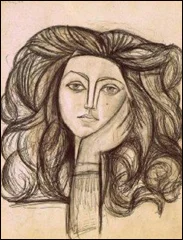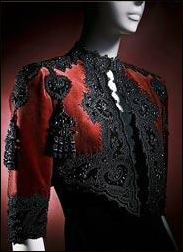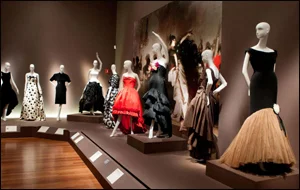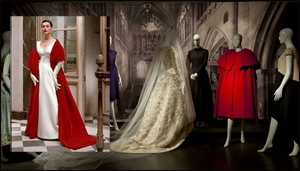Viva Picasso y España!
Wildcelt celebrates the exhilarating expressive arts of Spain. Mark Wilson will review the S.F. DE Young’s exhibition, Picasso Masterpieces from the Musée National Picasso, followed by a tribute to legendary Spanish couturier, Cristóbal Balenciaga…’’Balenciaga, Haute Couture…Iberian Style’’, plus some great Spanish film tie-ins.
Copyright 1995 Mark A. Wilson.
Left to right: Musee National Picasso, Medieval Walls of Avila Spain,
Lion statue fountain at the Alhambra Castle, City walls and castle at Toledo.
Pablo Picasso's reprehensible treatment of the women in his life is legendary. It's not only an important aspect of his personal life; it's crucial to understanding his art. The major exhibition, "Picasso: Masterpieces from the Musee National Picasso, Paris", at the De Young Museum in San Francisco through October 9th. 2011, makes this abundantly clear. Yet, as with many great artists throughout history, with Picasso one has to separate their judgment of his personal life from the quality of his art, in order to arrive at an objective assessment of his work. And even people who don’t like Picasso's signature Cubist style cannot deny that he is one of a handful of artists who forever changed the course of modern painting.
In the early years of his career, as the De Young exhibit illustrates, Picasso was heavily influenced by his Spanish roots. He was born in Malaga, in northern Spain, in 1881. He moved to Barcelona in 1896, where he lived for most of the next eight years while he studied painting and began his career as an artist. Picasso lived in Madrid for five months in 1901, and eventually moved to Paris in 1904 to open his own painting studio there. The years between 1901 and 1904 were known as his Blue Period, which is sparsely represented in the De Young exhibit. However, one outstanding example of this period that is included is "Woman with One Eye", from 1904.
In the next room are early Cubist works, executed shortly after he moved to Paris. One study for Picasso's first Cubist painting, "Les Demoiselles d’Avignon", in included here. This painting (the completed version of which is at the MOMA in New York), still evokes a controversy over Picasso's true inspiration for its theme. It depicts five women in the window of a brothel in Barcelona. Some historians believe Picasso frequented this brothel, and that therefore this painting objectifies the women it depicts. Picasso himself claimed he was trying to show the defiance of these women in the face of being forced to earn a living this way.
In 1918, Picasso married Olga Khokhlova, a dancer with Sergei Diaghilev's legendary "Ballet Russes" troupe. Their marriage was a stormy one, full of arguments and constant conflicts. Olga gave Picasso a son, Paulo, but the relationship ended in separation, (he wouldn't divorce her since he didn't want her to get half the wealth from his blossoming career). In 1927, when Picasso was 46, he met 17-year-old Marie-Therese Walter, the woman who was to become one of his most famous lovers, and a major source of inspiration for his painting during the next several years. Marie-Therese hoped Picasso would marry her, though he never intended to. They had a daughter together named Maya, but he carried on affairs with several other women while he was seeing her.
One of the most arresting images in the De Young exhibit is the oil painting "Portrait of Olga", from 1918. It is a sensitive study of a woman he was clearly in love with at the time he painted her, and the style is quite realistic, with meticulous detailing on her face and dress. By contrast, "Weeping Woman" an etching of Marie-Therese from 1937, was done in Picasso's much more typical late Cubist style. This work is a harshly unflattering image of a woman whose emotional dependence Picasso callously used, both as a subject for his work, and a source of perverse amusement for him.
During the late 1930s and early 1940's, Picasso had an intense romance with the photographer and painter Dora Marr. Perhaps the most iconographic painting in the De Young exhibit is "portrait of Dora Marr" from 1937. This is a large, colorful work in oil done in Picasso's best-known style of late Cubism, with a double-sided face and hands that appear to be disjointed. In 1943, Picasso broke off his relationship with Dora Marr to take up with the 21-year-old Francoise Gilot. He was 62 at the time, and their relationship lasted several years, producing two children, son Claude and daughter Paloma. Francoise eventually grew tired of Picasso's infidelity, verbal abuse, and domineering personality, and she left him in the early 50's, taking their children with her. This period of Picasso's life is well documented in the film "Surviving Picasso"
In 1953, Picasso took up with his last romantic partner, Jacqueline Roque, with whom he was to stay for the last 20 years of his life. She was 26 when they met and he was 72, and they were married in 1961. Included in the De Young exhibit is Picasso's portrait of her, "Jacqueline with Crossed Hands", from 1954. This late Cubist work was clearly inspired by Delacroix�s paintings of women in North African settings.
Pablo Picasso died in 1973, at the age of 92. By the time of his death, Picasso had earned an international reputation as the most important painter of the twentieth century, and one of the founding fathers of modern art. Yet anyone who has studied the unsettling story of his relationships with the women in his life must inevitably look at his art from a different perspective. Besides his undeniable achievements as a painter, he was a troubled soul who all too often took callous advantage of the women he was involved with, both on and off the canvas.
In addition to the boldly expressive Picasso exhibit at the deYoung...From March 26th –July 4th 2011, fashion connoisseurs were treated to Balenciaga and Spain, a modernistic exhibit examining the enduring Spanish cultural influences by the works of master couturier, Cristóbal Balenciaga. Similar in room displays to the resplendent Yves Saint Laurent exhibit in 2009, this was a careful study in the influences that Spain had on three decades of designer Cristóbal Balenciaga’s work.
From Humble Basque Beginnings To understand Balenciaga's fashion oeuvre one needs to examine his modest beginnings as a child in the Basque fishing village of Guetaria working alongside his seamstress mother, then later being discovered by the Marquessa de Casa Torres, the foremost Spanish noblewoman in his town who would become his first customer, then patron. After moving to San Sebastian Spain in 1918, which soon expanded to include atelier branches in Madrid and Barcelona, he was on his way to a meteoric rise in the fashion world, culminated by his move to Paris & opening his exclusive house of couture on Avenue George V in August 1937.
Balenciaga's fashion inspired from the corrida de toros… While winding my way past the glass of fashion, initially I was impressed by Balenciaga’s earlier works, the lacey, somber black evening dresses of the late 1950's and early 60's. But as I turned the corner and moved into the epicenter of the exhibit, that’s when the power of Balenciaga's Spanish influence overtook me. Instantly the exhibit came to life with its spectacular backdrops of great Spanish bullfights, with what seemed like rows of dazzling paillette-studded Bolero jackets inspired by matador's traje de luces (suit of lights). Also, alluded from the matadors costume was his use of pom-poms lining a Flamenco-esque evening gown.
Shades of Sevillanas bata de cola Dresses… In this display, Balenciaga's astute inventiveness was evident with his use of brilliantly colored ruffles impacted by Spanish dancer’s bata de cola dresses, while viewers were tantalized by evening gowns accented with flurries of twirling shawls tapped from traditional Flamenco dancer’s attire. Each dress and gown richly steeped in Balenciaga's nostalgia for the traditions of his native Spain.
The Religious Life
Next, I was drawn to the showcases of Balenciaga's clerically inspired designs. While viewing a gilded cape influenced by a priests opulently embroidered robes, I flashed on my favorite scene from Fellini's Roma, of a bizarre ecclesiastical fashion show where Fellini filmed a similar succession of embellished religious capes and tunics. It was apparent that Balenciaga's use of ceremonial motifs was heavily influenced by the hooded robes, habits & costumes of the Spanish Catholic Church.
Haunting expressions of Velasquez & Goya… The exhibits finale drew from Balenciaga’s admiration for Spanish painters Velásqueź and Goya. Here the featured backdrop was the entrancing "Las Mininas", royal court life is echoed in Balenciaga's 1939 Infanta dress, inspired by Velásqueź’ celebrated portrait of Margarita Theresa of Spain.
Balenciaga also drew inspiration from Goya's canny use of lighting, with his employment of undulating fabric using brightly colored, thickly textured cloth. For me, Balenciaga's fashion coup de grâce was an exquisite pure black velvet gown with black silk accents inspired by 16th century costumes worn during the golden age of Spain.
Balenciaga, fashions El Greco While observing comments comparing Balenciaga to Picasso or Miro, I would correlate Balenciaga more to El Greco… Whether designing mantilla influenced hats, or a dress inspired by the Duchess of Alba, Balenciaga was a true Spaniard and the love for his culture impacted his work throughout his life.
Viva Picasso y España summer film tie-ins…
Here we've chosen seven film tie-ins for you with either Spanish or Picasso themes...To be viewed with a pitcher of Sangria!
Barcelona…by Mark Wilson
In this campy, stylish, and amusing film, the city of Barcelona, with its many beautiful sites, provides a lovely backdrop for a witty and original story. The other focus is Anti-Americanism in Europe in the waning days of the Cold War. A young American naval officer visits his businessman cousin, with whom he’s had a life-long rivalry. While socializing with his cousin and his Spanish friends, the officer is mistaken for a CIA spy, and is soon the target of suspicion and hostility, some of it amusing, some of it dangerous. The suspicion soon builds to a crisis, which brings the two cousins much closer in the end. In today’s climate of Jihadist and Al Queda threats to all Americans, the theme of this film seems as relevant as it was when it was made in 1994.
El Cid...
A classic historical epic filmed in Spain, starring Charlton Heston
and the incomparable Sophia Loren.
10:30p.m. Summer…avant-guarde movie filmed entirely on location in Spain, by celebrated film director Jules Dassin, starring fiery Melina Mercouri, Peter Finch & the haunting Romy Schneider.
Modigliani…exquisitely poignant bio-pick about the life and loves of iconic painter, Amedeo Modigliani…highlighted is his stormy and competitive relationship with a young Pablo Picasso.
Carlos Saura's version of Flamenco Masterpiece Carmen, with Antonio Gades and Laura Del Sol...














